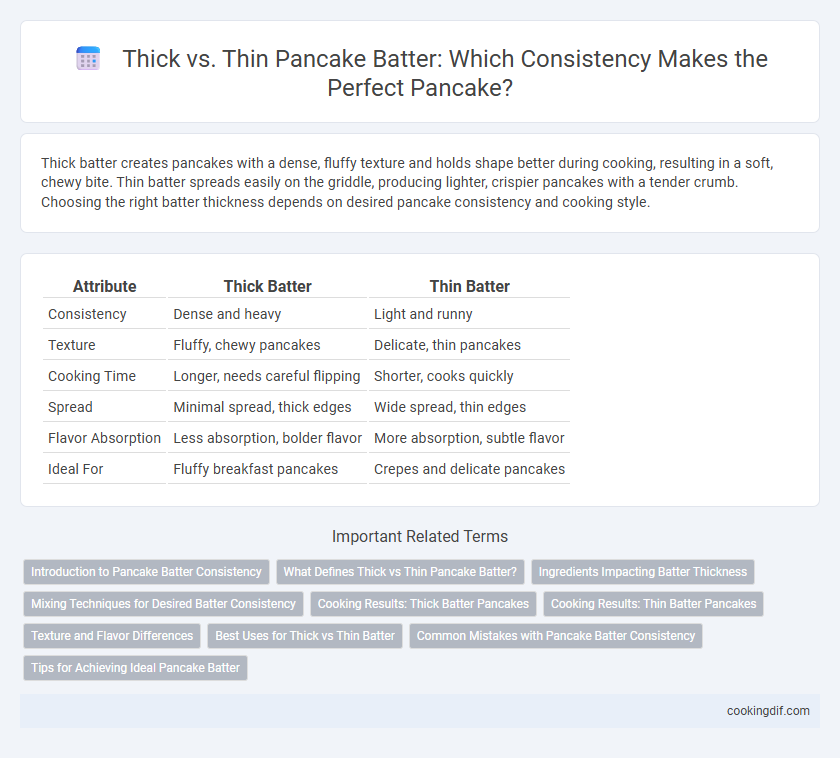Thick batter creates pancakes with a dense, fluffy texture and holds shape better during cooking, resulting in a soft, chewy bite. Thin batter spreads easily on the griddle, producing lighter, crispier pancakes with a tender crumb. Choosing the right batter thickness depends on desired pancake consistency and cooking style.
Table of Comparison
| Attribute | Thick Batter | Thin Batter |
|---|---|---|
| Consistency | Dense and heavy | Light and runny |
| Texture | Fluffy, chewy pancakes | Delicate, thin pancakes |
| Cooking Time | Longer, needs careful flipping | Shorter, cooks quickly |
| Spread | Minimal spread, thick edges | Wide spread, thin edges |
| Flavor Absorption | Less absorption, bolder flavor | More absorption, subtle flavor |
| Ideal For | Fluffy breakfast pancakes | Crepes and delicate pancakes |
Introduction to Pancake Batter Consistency
Thick pancake batter creates fluffy, tall pancakes by holding air bubbles during cooking, while thin batter spreads easily for thinner, crisper results. The ideal consistency balances viscosity and fluidity, ensuring even cooking and desired texture. Understanding batter thickness helps tailor pancakes to specific preferences, from light and airy to thin and delicate.
What Defines Thick vs Thin Pancake Batter?
Thick pancake batter contains less liquid and more flour, resulting in a dense consistency that produces fluffy, tall pancakes with a chewy texture. Thin pancake batter has a higher liquid-to-flour ratio, allowing it to spread easily on the griddle and cook into thinner, crispier pancakes with a delicate crumb. The balance of milk or water, eggs, and flour directly defines the pancake batter's viscosity and ultimately impacts the pancake's final texture and thickness.
Ingredients Impacting Batter Thickness
The thickness of pancake batter is primarily influenced by the ratio of flour to liquid, where higher flour content results in a denser, thick batter, while increased milk or water produces a thin batter consistency. Ingredients like eggs and melted butter also play a crucial role; eggs add structure and moisture, thickening the batter, whereas butter can thin it slightly when melted into the mixture. Adjusting these key components affects the final texture of the pancakes, with thick batter yielding fluffy and hearty pancakes and thin batter creating lighter, crepe-like results.
Mixing Techniques for Desired Batter Consistency
Achieving the ideal pancake consistency hinges on mastering mixing techniques tailored to thick versus thin batter. Thick batter requires gentle folding to retain air bubbles, ensuring fluffy, dense pancakes with a rich texture. Thin batter demands minimal mixing to avoid overdeveloped gluten, resulting in lighter, crisper pancakes with a tender crumb.
Cooking Results: Thick Batter Pancakes
Thick batter pancakes yield a denser, fluffier texture with a rich mouthfeel due to the higher flour-to-liquid ratio, which allows for better heat retention during cooking. This consistency results in pancakes that rise more evenly and hold shape well, producing a satisfying chew and prominent golden crust. The slower cooking process helps develop deeper flavor complexity and a tender interior, ideal for hearty breakfasts.
Cooking Results: Thin Batter Pancakes
Thin batter pancakes yield a lighter, fluffier texture with delicate edges that cook quickly and evenly. The reduced thickness allows heat to penetrate rapidly, preventing undercooked centers while producing a slightly crisp exterior. This consistency enhances absorption of syrup and toppings, making thin batter pancakes a preferred choice for a tender, flavorful breakfast experience.
Texture and Flavor Differences
Thick batter for pancakes produces a dense, fluffy texture with a rich, buttery flavor that holds syrup well. Thin batter results in a lighter, crispier pancake with a delicate mouthfeel and a more subtle taste. The consistency of the batter directly influences the final pancake's moisture retention and overall flavor intensity.
Best Uses for Thick vs Thin Batter
Thick pancake batter creates fluffy, dense pancakes ideal for stacking and holding toppings like syrup and butter without becoming soggy. Thin batter produces lighter, crisper pancakes with delicate edges, perfect for crepes or delicate breakfast options. Choosing the right batter consistency depends on the desired texture and presentation, with thick batter best for hearty pancakes and thin batter suited for elegant, thin pancakes.
Common Mistakes with Pancake Batter Consistency
Thick pancake batter often leads to dense, undercooked centers, while thin batter can cause pancakes to spread too much and become rubbery. Common mistakes include adding too much flour or liquid without measuring, resulting in inconsistent texture and uneven cooking. Ensuring the batter is smooth with a pourable but not runny consistency helps achieve fluffy, evenly cooked pancakes every time.
Tips for Achieving Ideal Pancake Batter
For ideal pancake batter, aim for a consistency that is thick enough to hold its shape on the griddle yet thin enough to spread slightly when poured. Use a ratio of about 1 cup of flour to 3/4 cup of milk for a medium-thick batter that yields fluffy pancakes. Avoid overmixing the batter to prevent toughness, and adjust with small amounts of milk or flour to achieve the perfect pourable texture.
Thick batter vs thin batter for consistency Infographic

 cookingdif.com
cookingdif.com